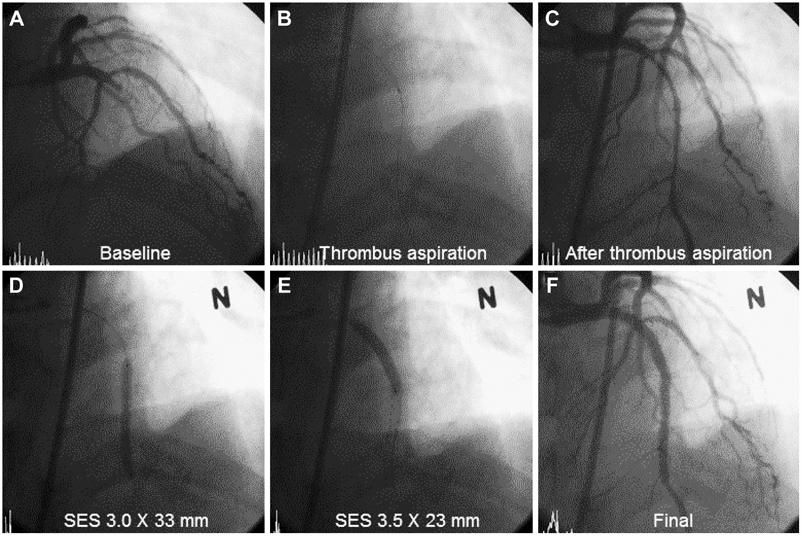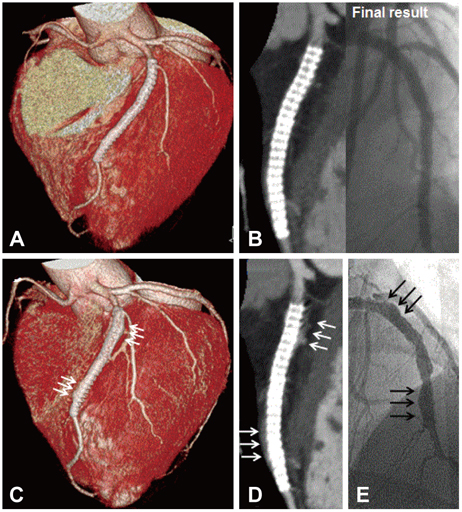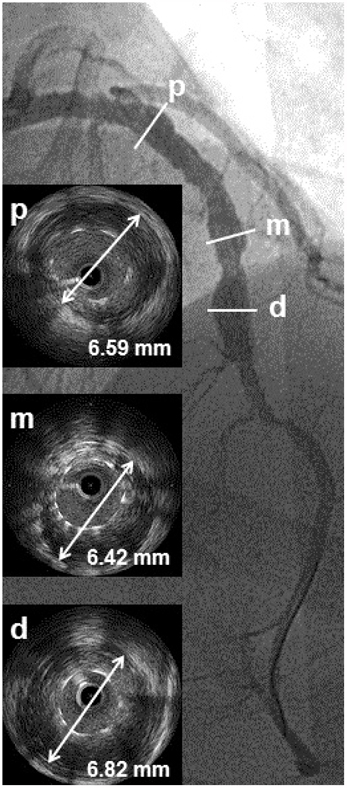Korean Circ J.
2011 Sep;41(9):559-562. 10.4070/kcj.2011.41.9.559.
Development of a Coronary Aneurysm at a Sirolimus-Eluting Stent-Implanted Lesion in a Patient With Churg-Strauss Syndrome
- Affiliations
-
- 1Department of Internal Medicine, Vision 21 Cardiac and Vascular Center, Ilsan Paik Hospital, Goyang, Korea. hmchoi49@naver.com
- 2Department of Rheumatology, Ilsan Paik Hospital, Goyang, Korea.
- 3Department of Radiology, Ilsan Paik Hospital, Goyang, Korea.
- KMID: 2094112
- DOI: http://doi.org/10.4070/kcj.2011.41.9.559
Abstract
- A coronary aneurysm (CA) can occur in sirolimus-eluting stent (SES)-implanted coronary lesions. Although several possible mechanisms have been suggested, the precise pathogenesis of a CA in SES-implanted lesions is still unknown. We report a patient with Churg-Strauss syndrome who underwent successful percutaneous coronary intervention with SES and then experienced a CA in an SES-implanted coronary lesion. We describe the CA characteristics through the use of coronary angiography, coronary 64-multidetector computed tomography, and intravascular ultrasound and discuss the etiological factors for the CA in this patient.
Keyword
MeSH Terms
Figure
Reference
-
1. Windecker S, Remondino A, Eberli FR, et al. Sirolimus-eluting and paclitaxel-eluting stents for coronary revascularization. N Engl J Med. 2005. 353:653–662.2. Nienaber CA, Akin I, Schneider S, et al. Clinical outcomes after sirolimus-eluting, paclitaxel-eluting, and bare metal stents (from the first phase of the prospective multicenter German DES.DE registry). Am J Cardiol. 2009. 104:1362–1369.3. Daemen J, Wenaweser P, Tsuchida K, et al. Early and late coronary stent thrombosis of sirolimus-eluting and paclitaxel-eluting stents in routine clinical practice: data from a large two-institutional cohort study. Lancet. 2007. 369:667–678.4. Bavry AA, Chiu JH, Jefferson BK, et al. Development of coronary aneurysm after drug-eluting stent implantation. Ann Intern Med. 2007. 146:230–232.5. Mavrogeni S, Manoussakis MN, Karagiorga TC, et al. Detection of coronary artery lesions and myocardial necrosis by magnetic resonance in systemic necrotizing vasculitides. Arthritis Rheum. 2009. 61:1121–1129.6. Masi AT, Hunder GG, Lie JT, et al. The American College of Rheumatology 1990 criteria for the classification of Churg-Strauss syndrome (allergic granulomatosis and angiitis). Arthritis Rheum. 1990. 33:1094–1100.7. Murthy PA, Mohammed TL, Read K, Gilkeson RC, White CS. MDCT of coronary artery aneurysms. AJR Am J Roentgenol. 2005. 184:3 Suppl. S19–S20.8. Alfonso F, Pérez-Vizcayno MJ, Ruiz M, et al. Coronary aneurysms after drug-eluting stent implantation: clinical, angiographic, and intravascular ultrasound findings. J Am Coll Cardiol. 2009. 53:2053–2060.9. Wagner AD, Meyer GP, Rihl M, et al. Acute coronary syndrome associated with Churg-Strauss syndrome. Vasc Health Risk Manag. 2007. 3:775–779.10. Noth I, Strek ME, Leff AR. Churg-Strauss syndrome. Lancet. 2003. 361:587–594.
- Full Text Links
- Actions
-
Cited
- CITED
-
- Close
- Share
- Similar articles
-
- A Case of Coronary Artery Aneurysm after Sirolimus-Eluting Stent Implantation
- Multiple Sequential Complications After Sirolimus-Eluting Stent Implantation: Very Late Stent Thrombosis, Stent Fracture, In-Stent Restenosis, and Peri-Stent Aneurysm
- A Case of Huge Coronary Aneurysm After Implantation of a Sirolimus-Eluting Stent
- Very Late Stent Thrombosis Related to Fracture of a Sirolimus-Eluting Stent
- Angiographic spontaneous pseudo-resolution of a coronary artery aneurysm after implantation of a sirolimus-eluting stent




